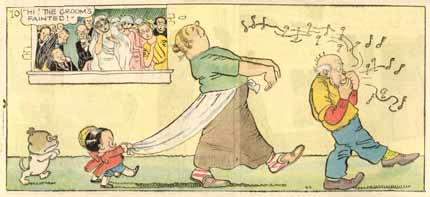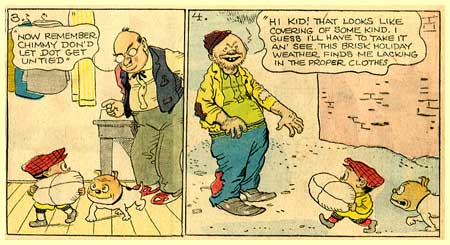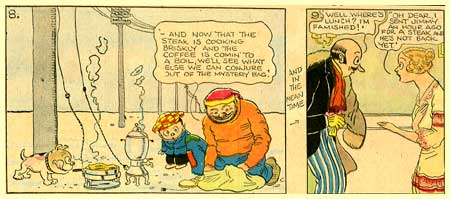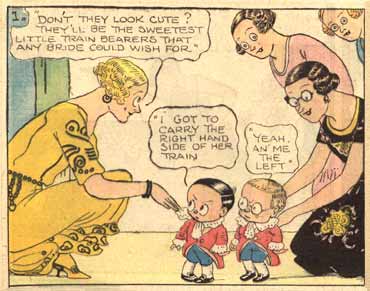Comic art by James Swinnerton.
James Guilford Swinnerton was a late 19th-century, early 20th-century U.S. comic artist. Born in Eureka, California, Swinnerton ranked Arthur Burdett Frost among his graphic influences. Swinnerton enrolled in the San Francisco Art School at the age of 14 and started his career as a cartoonist with the San Francisco Examiner. The little bear cubs of his strip 'The Little Bears & Tykes' (1892), were an immense hit with the public. They are among the earliest examples of comics about "funny animals", particularly in the United States. Just like R.F. Outcault's 'Yellow Kid', the series used a permanent cast of characters, and can be considered as one of the first comic strips. Intended for children, adults were equally captured by their extremely detailed antics. The journal's publisher, William Randolph Hearst, noticed how a popular comic can boost newspaper sales and therefore invested in more newspaper comics.
'Little Jimmy', 1922.
By 1896, Swinnerton, who signed his cartoons with "Swin", was the Examiner's political cartoonist as well, his drawings often filling the paper's front and inside pages. At the age of 21, Jimmy Swinnerton arrived at the top of his career, and stayed there for the rest of his life. By 1899, he moved to New York to work for the east coast branch of the newspaper, where he switched from bears to tigers in 'The Little Tigers', after the New York Democratic symbol, the Tammany Tiger.
In addition, Swinnerton created two completely new comics, 'Mount Ararat' and 'Mr. Jack'. In 1904, he started his most famous and longest-running strip, 'Little Jimmy', about a little boy who often loses his groceries after being sent to a shop and gets distracted from the simplest tasks, often due to vagabonds and hooligans. In the 1930s, The Fleischer Brothers adapted 'Little Jimmy' into an animated short, featuring Betty Boop.
'Little Jimmy', 1923.
Enormously productive, Jimmy Swinnerton undertook a great number of short-lived strips from the early 1900s on, such as 'Poor Jones', 'Professor Knix', 'Sweet Little Katy' and 'Sam and his Laugh'. Between 1900 and 1902, he revived Richard F. Outcault's 'The Evening Journal's Private Asylum', of which Outcault had previously drawn two episodes in 1898. In October 1916, Swinnerton succeeded A.C. Fera on the weekly comic 'An Embarrassing Moment' and continued it for another year.
Swinnerton suffered from tuberculosis and had to move to the dryer and smog-free climat of Arizona for health reasons. 'Little Jimmy' ran as a daily until 1937, and as a Sunday page, with 'Mr. Jack' as its topper until 1958. After 1920, his artistic interest shifted to the theme of American desert life. He started doing illustrations and developed his landscape painting. He also created 'Canyon Kids', a monthly page for Good Housekeeping magazine, which ran for 42 years and was also adapted into a series of animated cartoons by Warner Bros. Swinnerton painted until 1965, when his hands become too shaky. James Swinnerton died in 1974, at the respectable age of 98.
James G. Swinnerton was an influence on Oskar Andersson, Julius Stafford Baker II, Gene Carr (his 'Bearville' was obviously inspired by 'The Little Bears'), George Herriman, Guido Moroni-Celsi and Ralph Yardley. A celebrity fan of Swinnerton's 'Little Jimmy' was Pablo Picasso.
Comic art by Jimmy Swinnerton.






